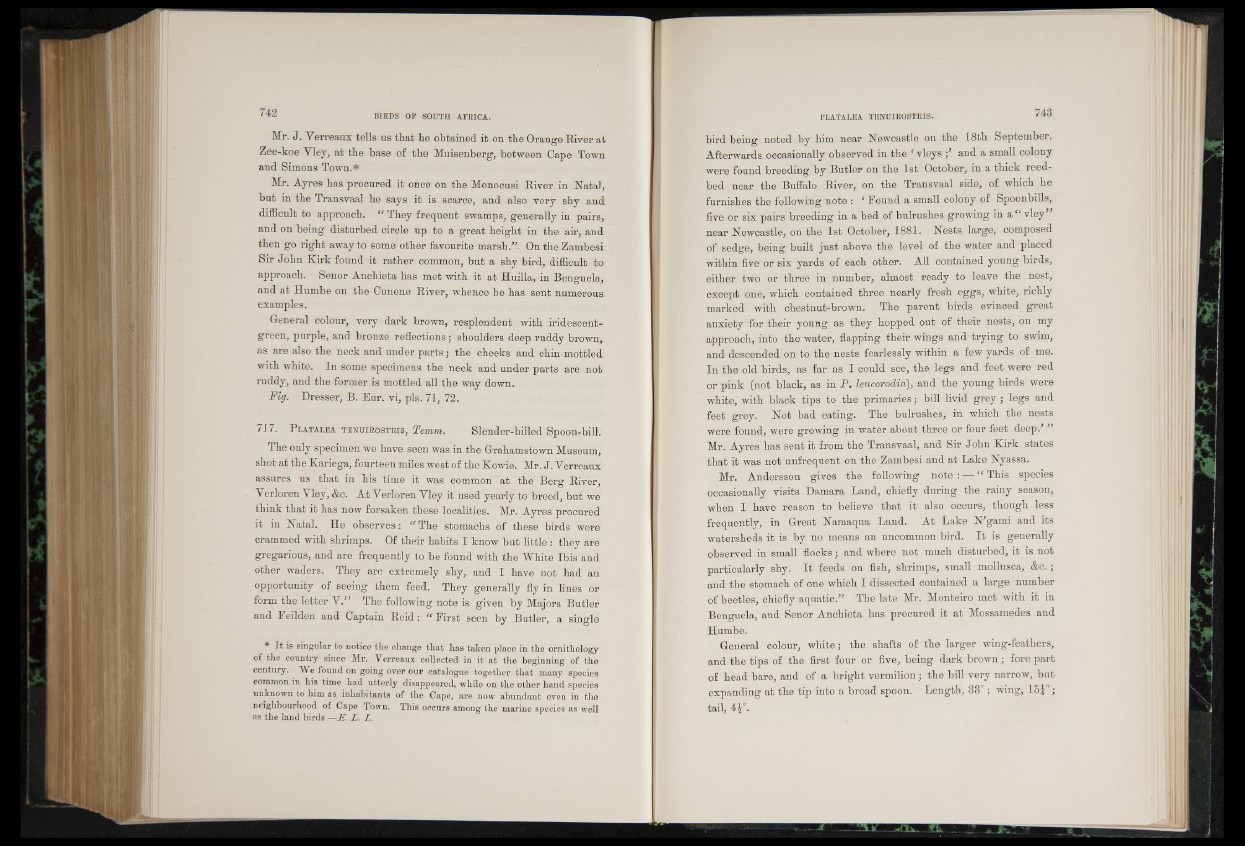
Mr. J . Yerreaux tells us that he obtained it on the Orange River at
Zee-koe Yley, at the base of the Muisenberg, between Oape Town
and Simons Town.*
Mr. Ayres has procured it once on the Monocusi River in Natal,
but in the Transvaal he says it is scarce, and also very shy and
difficult to approach. “ They frequent swamps, generally in pairs,
and on being disturbed circle up to a great height in the air, and
then go right away to some other favourite marsh.”. On the Zambesi
Sir John Kirk found it rather common, but a shy bird, difficult to
approach. Senor Anchieta has met with it at Huilla, in Beno-uela,
and at Humbe on the Ounene River, whence he has sent numerous
examples.
General colour, very dark brown, resplendent with iridescent-
green, purple, and bronze reflections; shoulders deep ruddy brown,
as are also the neck and under parts; the cheeks and chin .mottled
with white. In some specimens the neck and under parts are not
ruddy, and the former is mottled all the way down.
Fig. Dresser, B. Eur. vi, pis. 71, 72.
717. P latalea t e n u ir o st r is , Temm. Slender-billed Spoon-bill.
The only specimen we have seen was in the Grahamstown Museum,
shot at the Kariega, fourteen miles west of the Kowiei Mr. J. Yerreaux
assures us that in his time it was common at the Berg River,
Yerloren Yley, &c. At Yerloren Yley it used yearly to breed, but we
think that it has now forsaken these localities. Mr. Ayres procured
it in Natal. He observes: “ The stomachs of these birds were
crammed with shrimps. Of their habits I know but little : they are
gregarious, and are frequently to be found with the lYhite Ibis and
other waders. They are extremely shy, and I have Dot had an
opportunity of seeing them feed. They generally fly in lines or
form the letter Y.” The following note is given by Majors Butler
and Feilden and Captain Reid : “ First seen by Butler, a single
* I t is singular to notice the change that has taken place in the ornithology
of the country since Mr. Verreaux collected in it at the beginning of the
century. We found on going over our catalogue together that many species
common in his time had utterly disappeared, while on the other hand species
unknown to him as. inhabitants of the Cape, are now abundant even in the
neighbourhood of Cape Town. This occurs among the marine species as well
as the land birds —E. L. L.
bird being noted by him near Newcastle on the 18th September.
Afterwards occasionally observed in the ‘ vleys and a small colony
were found breeding by Butler on the 1st October, in a thick reed-
bed near the Buffalo River, on the Transvaal side, of which he
furnishes the following note : 1 Found a small colony of Spoonbills,
five or six pairs breeding in a bed of bulrushes growing in a “ vley
near Newcastle, on the 1st October, 1881. Nests large, composed
of sedge, being built just above the level of the water and placed
within five or six yards of each other. All contained young birds,
either two or three in number, almost ready to leave the nest,
except one, which contained three nearly fresh eggs, white, richly
marked with chestnut-brown. The parent birds evinced great
anxiety for their young as they hopped out of their nests, on my
approach, into the water, flapping their wings and trying to swim,
and descended on to the nests fearlessly within a few yards of me.
In the old birds, as far as I could see, the legs and feet were red
or pink (not black, as in P. leucorodia), and the young birds were
white, with black tips to the primaries; bill livid grey ; legs and
feet grey. Not bad eating. The bulrushes, in which the nests
were found, were growing in water about three or four feet deep.’ ”
Mr. Ayres has sent it from the Transvaal, and Sir John Kirk states
that it was not unfrequent on the Zambesi and at Lake Nyassa.
Mr. Andersson gives the following note : — “ This species
occasionally visits Damara Land, chiefly during the rainy season,
when I have reason to believe that it also occurs, though less
frequently, in Great Namaqua Land. At Lake N’gami and its
watersheds it is by no means an uncommon bird. It is generally
observed in small flocks; and where not much disturbed, it is not
particularly shy. It feeds on fish, shrimps, small mollusca, &c.;
and the stomach of one which I dissected contained a large number
of beetles, chiefly aquatic.” The late Mr. Monteiro met with it in
Benguela, and Senor Anchieta has procured it at Mossamedes and
Humbe.
General colour, white; the shafts of the larger wing-feathers,
and the tips of the first four or five, being dark brown; fore part
of head bare, and of a bright vermilion; the bill very narrow, but
expanding at the tip into a broad spoon. Length, 33'; wing, 15j";
tail, 4^''.